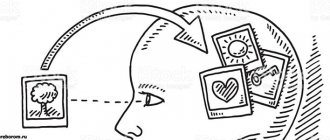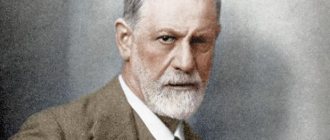Memory and attention are interrelated functions of human thinking. Without the ability to concentrate on the object of memorization and get an emotional return from studying this object, it is impossible to qualitatively learn the necessary material. In fact, a person’s attentiveness and interest are the main factors in their short-term memory.
This lesson provides information on how to train and develop attention and memory using special techniques and exercises, as well as recommendations for getting a vivid impression of the material being studied.
The role of attention
Attention is the selective focus of our sensory perception on a specific object. Attention helps to fix objects in our short-term memory, which is characterized by a limited storage time of information and the number of elements retained. This is the main role of attention for remembering information. The stronger and longer our concentration on an object, the better we can remember it.
You've probably noticed that some things are easy to remember if you pay a little attention to them. For example, many people have trouble remembering names when they first meet someone. To remember a name, you just need to think about it a little, try to mentally write it, and also remember or come up with several modifications of the name. Often such a short concentration of attention helps to remember a person’s name for a long time.
However, if you need to remember something more complex and voluminous, a short concentration of attention will no longer be enough, so it is important to know and use several important properties of our perception.
First, the human ability to retain information is limited. A study by American psychologist George Miller shows that a person’s attention span at any given moment is limited to 7 ± 2 objects.
Secondly, memorizing a large amount of data requires quite a long concentration and perseverance, which is associated with the ability to organize your time and consciousness.
Thirdly, memory and attention depend qualitatively on obtaining sensory experience about the memorized object, which is connected, on the one hand, with our emotional state, and on the other hand, with the attitude towards the memorized information.
It turns out that attention is often based on a person’s interests, needs and attitudes. Therefore, the development of short-term memory and mindfulness is achieved by working on focused concentration, as well as sensory experience. You will read about this further.
Ryuta Kawashima's Intelligence Development System
Japan is known for progress in almost every field. It was here that the Japanese system of intelligence development was developed.
According to Ryuta Kawashima's original method, solving simple timed arithmetic problems and reading aloud engages all hemispheres of the brain. In this way, memory is trained and developed, and negative consequences are erased. Reading helps slow down brain aging.
The author conducted an experiment among mentally ill patients suffering from dementia and Alzheimer's disease. After 30 days of training according to the Kawashima system, patients showed a slowdown in the development of the disease. Brain function improved significantly. It was previously almost impossible to delay the suppression of cognitive functions in this disease. The author's book itself consists of a number of simple arithmetic tasks, visual illustrations and comments.
Improving the organization of attention
As already mentioned, attention is the selective focus of our perception. Attention can be voluntary (or controlled) and involuntary (or uncontrolled). The presence of voluntary attention in a person helps a person to carry out conscious activities, including purposeful memorization.
To learn how to activate and control voluntary attention, you can use special exercises and techniques that will help you concentrate. You will find many of these techniques in other trainings. Here we describe exactly those techniques that are useful for concentrating attention during the memorization process.
Motivation. To improve attention, try to motivate yourself with the idea that the material you are studying can be useful to you. Try to understand all the possible benefits of mastering the information you need to learn. Even if they are insignificant, the main thing is to find them.
External stimuli. Some people have one very important ability: they can do something when there is noise and turmoil around them. Often this is a matter of habit, for example, when a person lives in a small apartment or dormitory, and he has to adapt to difficult conditions and do work without paying attention to anything. Difficult conditions make a person “impenetrable”, help a person learn to organize his attention and disconnect from external stimuli. Try to artificially create difficult conditions for yourself, try to concentrate on reading while you are listening to music, when people are walking around. Go outside to the park on a day off and read on a bench, trying not to pay attention to others and passers-by.
The state of trance , according to the observations of hypnosis specialist M. Erickson, is characterized by increased attention, the ability not to react to external stimuli, as well as the ability to ignore signals from some sensory organs. The training related to learning to enter a trance state is being created by our authors; as soon as it is ready, a link will appear here.
I would also like to note that you can often find advertisements on the Internet for various drugs and vitamins to improve memory and attention. However, it is important to understand that the true cause of inattention and forgetfulness lies not in the chemical and biological processes of the human body, but in the psychological state and motivation. Therefore, resort to using these drugs only as a last resort, when nothing else helps, and only as prescribed by a doctor.
Of course, good concentration cannot be achieved instantly; it is necessary to systematically work to improve it. Here are some tips regarding the problem of concentration and ways to organize attention:
- Don't stop and don't give up.
Very often, when completing a task, we stop halfway and succumb to the temptation to slip away from the work without completing it. Try to fight this desire, for example, by applying the rule of five. If you are reading a book, about
Thinking
Note 2
Thinking is understood as the process of human mental activity, the highest form of his creative activity.
The distinctive features of thinking include the creative processing of existing ideas and the creation of new ones, the ability to reflect both individual objects, phenomena, properties, and the connections that exist between them, an indirect reflection of the surrounding world.
Classification of thinking occurs on different grounds. The division into theoretical and practical thinking based on the nature of the problems being solved is most often used.
In terms of the degree of development, it can be discursive and intuitive, and in terms of originality, reproductive and productive thinking are distinguished.
Thinking is also classified according to form - visual-effective, visual-figurative, verbal-logical. Visual-effective thinking is quite often used in everyday life and is aimed at solving practical actions, for example, you need to learn how to press buttons on a tape recorder. This most elementary form of thinking is the basis for the formation of its more complex types. The basis of visual-figurative thinking is perception or representation, because problems are solved through images.
It must be said that ways of thinking and images of perception differ from each other in their generality and abstraction - only the important and most essential properties are reflected in the ways of thinking.
Verbal-logical thinking refers to conceptual thinking; problem solving occurs through reasoning. A concept is the essential properties of phenomena and objects in the surrounding world, which are divided into general and specific. If, for example, an apple or birch tree is planted, and not just a tree, then this is a specific concept.
It is human nature to reason while thinking. Judgments can be general, particular, or individual.
As for general judgments, they contain information about all objects and phenomena, both affirmative and negative. Private judgments include only part of the objects and phenomena that are included in the concept. With a single judgment, we are talking about an individual concept, for example, Tanya draws excellently. In the course of any reasoning, conclusions are drawn that create new judgments. The new judgment is called inference.
If an inference is made from the particular to the general, then it will be induction, and the reverse process is called deduction.
In reality, there are a huge number of types of thinking that are interconnected. People differ from each other in the quality of thinking - the breadth and depth of the mind, independence of thinking, its flexibility, speed and criticality.
The development of thinking occurs in the process of mastering knowledge, the sources of which are school, books, the media, radio and television, etc.
How to make a lasting impression
A person's impressions of remembered information have 2 useful properties that help our memory. Firstly, interest in the object of memorization makes us more attentive, and secondly, emotions help to better consolidate the object in our long-term memory.
Below are several principles that you can use to increase the importance of emotional perception in remembering information. These principles will help you create a strong, vivid first impression of the object of memory and retain it in your memory.
- First impression. It is useful to create a first emotional impression of a memorized object, and to record it in memory as accurately as possible.
- Visual image. First of all, try to get a visual impression as it is stronger. The nerves leading from the eye to the brain are twenty times thicker than the nerves leading from the ear to the brain.
- Great impression. If possible, in addition to visual perception, try to receive impressions using as many senses as possible, which will help you experience it more strongly.
- Play again. Try to revive in your memory the first impression of the memorized object more often. It is better to be under the first impression and not try to get a new one.
- Find similar. While reproducing your first impression of an object, think about what that impression is like and whether you have experienced something similar before.
In addition to these principles, you can also use special techniques for organizing the process of memorizing information. These techniques allow you to enhance emotional impact and awaken interest in the material being studied.
Games. Try to always find something interesting in your routine, turning any action into a game. This is what good parents do who want their child to do some boring work. Games are characteristic of many living beings; it is embedded in us at the genetic level. Excitement is important in the game!
Excitement translated from French means passion, enthusiasm, passion, excessive ardor. To create a gambling game, you must decide on the rules of this game and establish clear conditions for winning this game. Then your excitement will force you to be more attentive and concentrated.
Competitiveness. The vast majority of people are passionate about trying to “be better” than their opponent. Therefore, individual lessons are not as effective as group lessons. And in memory training you can find yourself an opponent and try to surpass him.
Personal records. Another factor that creates excitement when reading can be the struggle with oneself to achieve a certain result. Personal records can be set in the speed of memorization, the amount of information learned, and much more.
So the first rule says:
To better remember some information, it is important to concentrate on it and try to get an emotional return.
Is a complete mapping of our brain impossible?
The project of mapping all the connection points of neurons is called connectome. So far, we have only been able to describe the connectome of a nematode worm measuring about 1 mm, whose nervous system consists of just over 300 neurons.
As for describing the connectome of the human brain, which contains ~86 billion nerve cells, there is still no general idea of the scale of this project.
What is clear is that it is much more complex than deciphering the human genome or even the proteome (a set of proteins).
Scientists, for example, are attempting to describe the rat brain in this way. “We mapped an area the size of a match head - it took terabytes of memory. And it’s not clear what to do with such a volume of information,” says Russian anthropologist and popularizer of science Stanislav Drobyshevsky. He emphasizes that the problem is that we are trying to comprehend the results of these studies “with the same brain, which no longer accommodates information about itself - it turns out to be a vicious circle.” To understand how our brains work, we need a “bigger brain than ours.”
Types of memory
Memory is the mental process of preserving and reproducing past experiences, allowing one to accumulate information without losing previous knowledge and skills. It allows a person to expand his cognitive abilities. In order for there to be more such knowledge, this psychological process needs to be developed. First, you should determine what type of memory you have best “pumped up”. There are 4 types of this cognitive ability:
- Auditory
- allows a person to understand the meaning of information and quickly process it. - Visual
– thanks to it you can receive and save visual images and subsequently reproduce them in your mind. - Motor
– with its help a person can record and reproduce movements, developing skills. - Complex
– memory that combines the above skills.
Types of memory
Depending on the duration of consolidation and storage of received information, memory is divided into short-term, long-term and operational.
Long-term memory is the ability to recall information throughout life, such as where we were born, what school we graduated from, and so on. The memory constantly refers to past experience, supplements it with new information, and corrects the acquired information. To put it simply, a person does not need to memorize what he knows well.
We need short-term memory in order not to fill the brain with unnecessary information. For example, the confirmation code sent via SMS to register on the site will never be useful to you again, and you are unlikely to remember it in a few hours.
Working memory refers to memorization that is needed for certain situations. A person can hold in his head the information he needs to do real work. When data becomes irrelevant, the brain erases it, making room for new events.









